![]()
![]()
![]()
Use LEFT and RIGHT arrow keys to navigate between flashcards;
Use UP and DOWN arrow keys to flip the card;
H to show hint;
A reads text to speech;
37 Cards in this Set
- Front
- Back
|
Know the four mechanisms for CNS infections
|
1. Hematogenous spread(most common)
2. Traumatic implantation 3. Local extension from nearby infection 4. Ascent of peripheral nerve |
|
|
Define meningitis
|
Inflammation of pia matter covering the brain
|
|
|
What is the pathogenesis of meningitis
|
Usually due to hematogenous spread
|
|
|
What are the clinical and CSF laboratory findings meningitis
|
Clinical findings are fever, nuchal rigidity, headache.
CSF findings Laboratory findings in viral meningitis a.Increased CSF protein - due to ↑ vessel permeability b. Increased total CSF leukocyte count - initially neutrophils then converst to lymphocytes in 24 hrs. Laboratory findings in bacterial and fungal meningitis a. Increased CSF protein b. Increased total CSF leukocyte count c. Decreased CSF glucose |
|
|
Identify the gross findings of meningitis
|
Fever, nuchal rigidity, headache.
↑ CSF protein (viral, bacterial, fungal); ↓ CSF glucose (bacterial, fungal) |
|
|
Know the four mechanisms for CNS infections
|
1. Hematogenous spread(most common)
2. Traumatic implantation 3. Local extension from nearby infection 4. Ascent of peripheral nerve |
|
|
Define meningitis
|
Inflammation of pia matter covering the brain
|
|
|
What is the pathogenesis of meningitis
|
Usually due to hematogenous spread
|
|
|
What are the clinical and CSF laboratory findings meningitis
|
Clinical findings are fever, nuchal rigidity, headache.
CSF findings Laboratory findings in viral meningitis a.Increased CSF protein - due to ↑ vessel permeability b. Increased total CSF leukocyte count - initially neutrophils then converst to lymphocytes in 24 hrs. Laboratory findings in bacterial and fungal meningitis a. Increased CSF protein b. Increased total CSF leukocyte count c. Decreased CSF glucose |
|
|
Identify the gross findings of meningitis
|
Fever, nuchal rigidity, headache.
↑ CSF protein (viral, bacterial, fungal); ↓ CSF glucose (bacterial, fungal) |
|
|
Be able to differentiate the bacterial/fungus causes of meningitis from viral meningitis using CSF studies
|
CSF Bacterial/Fungus
TCC 1,000 - 20,000 cells/μL DifC >90% neutrophils & mononuclear CSF glucose Decreased CSF protein Increase Gram Stain Frequently positive sensitivity (75 to 80%) CSF Viral TCC <1,000 cells/μL DiffC first 24-48 hrs, neutrophils then switches to monocytes after 48 hours. CSF glucose normal, except Mumps, Herpes CSF Protein increased Gram Stain Negative |
|
|
Define encephalitis and the clinical findings that differentiate it from meningitis.
|
1. Inflammation of the brain
2. Clinical findings a. Fever, headache b. Impaired mental status, drowsiness Impaired mental status & drowsiness differentiate encephalitis from meningitis |
|
|
Know the pathogenesis of a cerebral abscess.
|
- Spread from an adjacent focus of infection (e.g., sinuses)
- Hematogenous spread (e.g., infective endocarditis) |
|
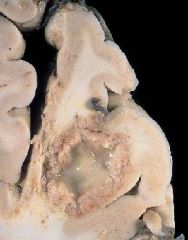
What is this
|

cerebral abscess
|
|
|
Arboviruses
|
Disease: encephalitis
Comments: Mosquitos are the vector. Wild birds are the reservoir for the virus. West Nile virus: crows and other birds are spreading the disease from New York to the west coast. |
|
|
Coxsackievirus
|
Disease: Meningitis
Comments: Most common cause of viral meningitis. Viral meningitis peaks in late summer and early autumn |
|
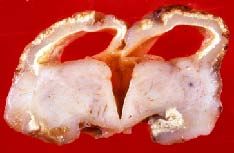
Cytomegalovirus
|

Disease: Encephalitis
Comments: Most common viral infection in AIDS. Primarily intranuclear basophilic inclusions. Periventricular calcification in newborns. |
|
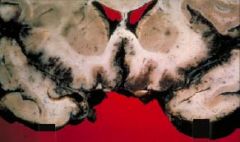
Herpes simplex virus type 1
|

Disease: Encephalitis & Meningitis
Comments: Causes hemorrhagic necrosis of temporal lobes |
|
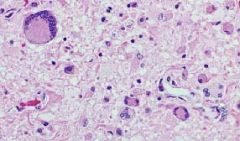
HIV
|

Disease: Encephalitis
Comments: Most common cause of AIDS dementia. Microglial cells to from multinucleated cells. |
|
|
Lymphocytic choriomeningitis
|
Disease: Meningitis & encephalitis
Comments: Endemic in the mouse population. Transmission: food or water contaminated with mouse urine/feces. Meningoencephalits: combination of nuchal rigidity and mental status abnormalities (encephalitis). CSF Findings: increased protein, lymphocyte infiltrate, normal to decreased glucose. |
|
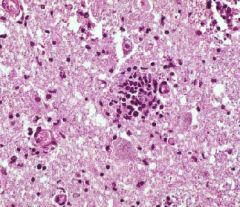
Polio virus
|

Disease: Encephalits and myelitis (spinal cord)
Comments: Destroys upper and lower motor neurons (anterior horn cells). Causes muscle paralysis. |
|
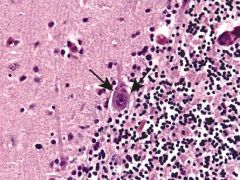
Rabies
|

Disease: Encephalitis
Comments: Most often transmitted by raccoon (40% of cases). Other vectors are dog, skunk, bat and coyote. Virus ascends peripheral nerves. Neurons contain intracytoplasmic Negri bodies. CNS excitability stage followed by flaccid paralysis. |
|
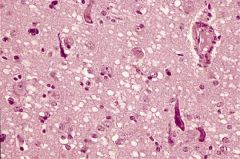
Creutzfeldt-Jakob disease
|

Unconventional slow virus encephalitis due to prions (proteinaceous material devoid of RNA or DNA). Transmitted by corneal transplantation,contact with human brain, used of improperly sterilized cortical electrodes, or ingestion of tissues from cattle with bovine spongiform encephalopathy ("mad cow" disease).
Brain has "bubble and holes" spongiform change in cerebral cortex. Death usually occurs within 1 year. |
|
|
Progressive multifocal leukoencephaly
|
Conventional slow virus encephalitis due to papovavirus.
Intranuclear inclusion in oligodendrocytes. Occurs in AIDS when CD4 T helper count <50 cells per μL. |
|
|
Subacute sclerosing panencephalitis
|
Conventional slow virus encephalitis associated with rubeola (measles) virus.
Intranuclear inclusion in neurons and oligodendrocytes. |
|
|
Group B streptococcus (Streptococcus agalactiae)
|
Disease: Neonatal meningitis
Comments: Gram positive coccus -Most common cause of neonatal meningitis -Spreads from a focus of infection in maternal vagina |
|
|
Escherichia coli
|
Disease: Neonatal meningitis
Comments: Gram negative rod Second most common cause of neonatal meningitis |
|
|
Listeria monocytogenes
|
Disease: Neonatal meningitis
Comments: Gram-positive rod with tumbling motility Pathogen found in soft cheese, hot dogs |
|
|
Neisseria meningitidis
|
Disease: Meningitis
Comments: Gram negative diplococcus Most common cause of meningitis between 1 month and 18 years of age |
|
|
Streptococcus pneumoniae
|
Disease: Meningitis
Comments: Gram positive diplococcus Most common cause of meningitis in patients > 18 years of age |
|
|
Mycobacterium tuberculosis
|
Disease: Meningitis
Comments: Complication of primary tuberculosis Involves base of brain Vasculitis (infarction) and scarring (hydrocephalus) |
|
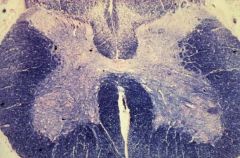
Treponema pallidum
|

Disease: Meningitis, encephalitis, and myelitis
Comments: Spirochete Types of neurosyphilis: -Meningovascular: vasculitis causing strokes -General paresis: dementia -Tabes dorsalis: involves dorsal root ganglia and dorsal column. Causes ataxia, loss of vibration sensation, absent deep tendon reflexes, Argyll Robertson pupil (pupils accommodate but do not directly react to light). |
|
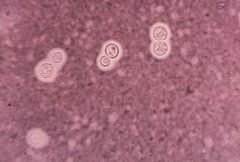
Cryptococcus neoformans
|

Disease:Meningitis and encephalitis
Comments: Occurs in immunocompromised host Most common fungal CNS infection in AIDS |
|
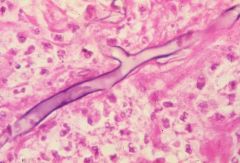
Mucor species
|

Disease: Frontal lobe abscess
Comments: Occurs in diabetic ketoacidosis. Spreads from frontal sinuses |
|
|
Naegleria fowleri
|
Disease: Meningoencephalitis
Comments: Involves frontal lobes Contracted by swimming in fresh-water lakes |
|
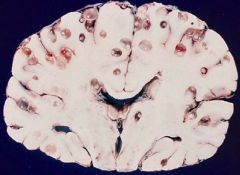
Taenia solium
|

Disease: Cysticercosis
Comments: Patient (intermediate host) ingests food or water containing eggs. Eggs develop into larval forms (cysticerci) that invade brain, producing calcified cysts causing seizures. |
|
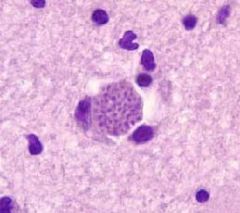
Toxoplasma gondii
|

Disease: Encephalitis
Comments: Most common CNS space-occupying lesion in AIDS Congenital toxoplasmosis produces basal ganglia calcification |

